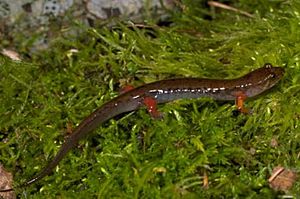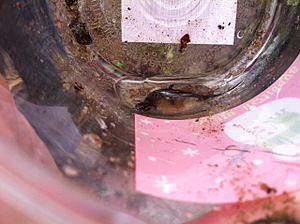Imitator salamander facts for kids
Quick facts for kids Imitator salamander |
|
|---|---|
 |
|
| Conservation status | |
| Scientific classification | |
| Synonyms | |
|
The imitator salamander (Desmognathus imitator) is a type of salamander. It belongs to a group called Plethodontidae. These salamanders breathe through their skin and mouth lining instead of lungs! This special salamander lives only in the Appalachian Mountains in the Eastern United States.
Contents
What Does It Look Like?
The imitator salamander is usually dark brown or black. Sometimes, it has a light, broken stripe down its back. A pale line often connects its eye to its jaw. You might also spot red or orange patches on its cheeks. Its back legs are usually thicker and stronger than its front legs.
Where Does It Live?
The imitator salamander lives in the Appalachian Mountains. You can find it in parts of Tennessee and North Carolina. It prefers higher places, more than 900 meters (about 3,000 feet) above sea level. Its home stretches from the Great Smoky Mountains in the north. It goes all the way south to the Plott Balsams and Great Balsam Mountains.
Its Home Environment
This salamander likes to live near streams. It can be found on wet rocks or on the forest floor in high-altitude areas. It shares its home with another salamander, the Ocoee salamander (Desmognathus ocoee). However, the imitator salamander usually stays closer to the water.
How Does It Live?
The imitator salamander is not poisonous. But it cleverly copies the look of another salamander. This is called Batesian mimicry. It mimics the red-cheeked salamander (Plethodon jordani), which is poisonous. This trick helps keep predators away!
Adult imitator salamanders hide during the day. They come out at night to search for small bugs and other tiny creatures. Birds, mammals, snakes, and the spring salamander (Gyrinophilus porphyriticus) might hunt them.
Life Cycle and Reproduction
Imitator salamanders usually breed in the summer. A female lays about 20 eggs. She attaches them to the underside of a rock in a wet spot, like a damp area or a seep. The mother stays with her eggs until they hatch.
When the eggs hatch, tiny larvae emerge. These young salamanders might live among wet moss, under rocks, or in leaf litter. We don't know much about how they grow. But they likely eat small invertebrates. They change into young salamanders (juveniles) when they are about 10 months old. This change is called metamorphosis.
What Is Its Conservation Status?
The imitator salamander is listed as "least concern" by the IUCN Red List of Threatened Species. This means it is not currently in danger of disappearing. Even though we don't know the exact number of salamanders, their population seems to be steady.
Most of its living area is inside national parks. This helps protect the species. However, a small group of these salamanders on Waterrock Knob is at risk. They face a threat of local extinction. The Great Smoky Mountains get a lot of acid rain. But there is no clear proof that this is harming the salamander population.



